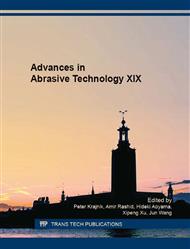[1]
S.Y. Liang, Mechanical machining and metrology at micro/nano scale[C]/Third International Symposium on Precision Mechanical Measurements. International Society for Optics and Photonics, 2006: 628002-628002-8.
DOI: 10.1117/12.715241
Google Scholar
[2]
K. Popov, S. Dimov, A. Ivanov, D.T. Pham, E. Gandarias , New Tool–Workpiece Setting Up Technology for Micro-milling. International Journal of Advances in Manufacturing Technology 47(1-4) (2010) 21–27.
DOI: 10.1007/s00170-009-2055-2
Google Scholar
[3]
W. Hundt, D. Leuenberger, F. Rehsteiner, An approach to monitoring of the grinding process using acoustic emission (AE) technique, Ann. CIRP 43 (1) (1994) 295–298.
DOI: 10.1016/s0007-8506(07)62217-3
Google Scholar
[4]
K.A. Bourne, M.B.G. Jun, S.G. Kapoor, R.E. DeVor, An Acoustic Emission-based Method for Determining Contact between a Tool and Workpiece at the Microscale. Journal of Manufacturing Science and Engineering Transactions of ASME130(3) (2008).
DOI: 10.1115/1.2917285
Google Scholar
[5]
S. Min, J. Lidde, N. Raue, D. Dornfeld. Acoustic emission based tool contact detection for ultra-precision machining. CIRP Annals - Manufacturing Technology 60 (2011) 141–144.
DOI: 10.1016/j.cirp.2011.03.079
Google Scholar
[6]
D. Dornfeld, H. Cai, An investigation of grinding and wheel loading using acoustic emission, Transactions of ASME, 106, pp (1984) 28–33.
DOI: 10.1115/1.3185907
Google Scholar
[7]
C. Jiang, H.L. Li, Y.F. Mai, D.B. Guo, Material removal monitoring in precision cylindrical plunge grinding using acoustic emission signal, Proc IMechE Part C: J Mechanical Engineering Science 2014, Vol. 228(4) 715–722.
DOI: 10.1177/0954406213489652
Google Scholar
[8]
A.W. Warren, Y.B. Guo, Acoustic emission monitoring for rolling contact fatigue of super finished ground surfaces[J]. International journal of fatigue, 2007, 29(4): 603-614.
DOI: 10.1016/j.ijfatigue.2006.07.010
Google Scholar
[9]
Z. Yang, Z. Yu, C. Xie, et al, Application of Hilbert–Huang Transform to acoustic emission signal for burn feature extraction in surface grinding process[J]. Measurement, 2014, 47: 14-21.
DOI: 10.1016/j.measurement.2013.08.036
Google Scholar
[10]
T. W, Liao, Feature extraction and selection from acoustic emission signals with an application in grinding wheel condition monitoring[J]. Engineering Applications of Artificial Intelligence, 2010, 23(1): 74-84.
DOI: 10.1016/j.engappai.2009.09.004
Google Scholar


